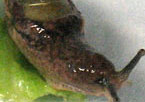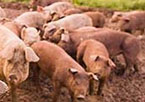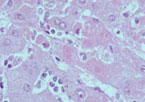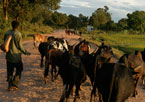Clostridium difficile - an Emerging Zoonosis?
Posted April 16, 2009 by Ali S. Khan | ![]() 0 Comments
0 Comments
 Recent studies have isolated a bacterium called Clostridium difficile from meats sold in grocery stores. C. difficile causes a severe colon infection and is generally acquired in hospitals and long-term care facilities, but 20% of cases are acquired in the community - outside of healthcare settings. Could C. difficile be a source of infection from retail meats...
Recent studies have isolated a bacterium called Clostridium difficile from meats sold in grocery stores. C. difficile causes a severe colon infection and is generally acquired in hospitals and long-term care facilities, but 20% of cases are acquired in the community - outside of healthcare settings. Could C. difficile be a source of infection from retail meats...
Snails, Slugs, and Semi-slugs: A Parasitic Disease in Paradise
Posted April 3, 2009 by Alex daSilva | ![]() 0 Comments
0 Comments
 ...CDC’s Division of Parasitic Diseases was contacted by the Hawaii Department of Health for advice regarding three cases of presumed Angiostrongylus cantonensis (AC) infection. AC, commonly called the rat lungworm, is a parasitic worm and the most common infectious cause of eosinophilic (a type of white cell) meningitis in humans worldwide...
...CDC’s Division of Parasitic Diseases was contacted by the Hawaii Department of Health for advice regarding three cases of presumed Angiostrongylus cantonensis (AC) infection. AC, commonly called the rat lungworm, is a parasitic worm and the most common infectious cause of eosinophilic (a type of white cell) meningitis in humans worldwide...
NCIS Atlanta: Severe Rash Illness in Baja
Posted March 18, 2009 by Ali S. Khan | ![]() 0 Comments
0 Comments
 A mysterious cluster of illnesses and deaths of unknown cause was recently reported in Baja California, a Mexican state that – as the Spanish translation suggests – is situated just below the border. Our shared border with Mexico fosters a mutual interest in epidemiologic events like this one - where time is of the essence and lives are at stake...
A mysterious cluster of illnesses and deaths of unknown cause was recently reported in Baja California, a Mexican state that – as the Spanish translation suggests – is situated just below the border. Our shared border with Mexico fosters a mutual interest in epidemiologic events like this one - where time is of the essence and lives are at stake...
Simian Malaria in Humans: Hard to Tell
Posted March 13, 2009 by Jimee Hwang | ![]() 0 Comments
0 Comments
 In medical school, I learned that four species of Plasmodium cause malaria in humans—P. falciparum, P. vivax, P. ovale, or P. malariae. Numerous malaria species infect other animals but I learned that they were of little public health significance to humans. However, that may no longer be true...
In medical school, I learned that four species of Plasmodium cause malaria in humans—P. falciparum, P. vivax, P. ovale, or P. malariae. Numerous malaria species infect other animals but I learned that they were of little public health significance to humans. However, that may no longer be true...
Food Safety: Need for Speed
Posted February 2, 2009 by Ali S. Khan | ![]() 0 Comments
0 Comments
 On January 29th, I met with the Executive Board of the Council of State and Territorial Epidemiologists. Needless to say, the conversation quickly strayed to the current Salmonella Typhimurium outbreak associated with peanut butter. These conversations among colleagues are noteworthy for being quite frank...
On January 29th, I met with the Executive Board of the Council of State and Territorial Epidemiologists. Needless to say, the conversation quickly strayed to the current Salmonella Typhimurium outbreak associated with peanut butter. These conversations among colleagues are noteworthy for being quite frank...
Imported Marburg Hemorrhagic Fever: One That Got Away
Posted January 30, 2009 by Ali S. Khan | ![]() 0 Comments
0 Comments
 CDC’s Special Pathogens Branch recently diagnosed a case of Marburg hemorrhagic fever in a U.S. traveler who returned from Uganda back in January 2008. This person had visited the famous “python cave” in Maramagambo Forest, Queen Elizabeth Park, western Uganda...
CDC’s Special Pathogens Branch recently diagnosed a case of Marburg hemorrhagic fever in a U.S. traveler who returned from Uganda back in January 2008. This person had visited the famous “python cave” in Maramagambo Forest, Queen Elizabeth Park, western Uganda...
Ingredient Driven Outbreaks: The Inside is Bigger than the Outside
Posted January 27, 2009 by Ali S. Khan | ![]() 0 Comments
0 Comments
 The broad distribution of peanut butter and peanut paste shipped to food manufacturing companies from this single plant throughout the country has triggered the recall of nearly two hundred food products and exposed a critical factor supporting the continued emergency of food-borne outbreaks...
The broad distribution of peanut butter and peanut paste shipped to food manufacturing companies from this single plant throughout the country has triggered the recall of nearly two hundred food products and exposed a critical factor supporting the continued emergency of food-borne outbreaks...
Salmonella Typhimurium Outbreak Investigation: Do Not Try This at Home
Posted January 14, 2009 by Ali S. Khan | ![]() 2 Comments
2 Comments
 There are numerous interesting features of this outbreak that highlight the complex issues I discussed recently for foodborne outbreaks. There was an unrelated overlapping outbreak, several PulseNet patterns involved, a State Health Department being the first to pull the trigger for a product advisory, and a contaminated ingredient that is in many foods...
There are numerous interesting features of this outbreak that highlight the complex issues I discussed recently for foodborne outbreaks. There was an unrelated overlapping outbreak, several PulseNet patterns involved, a State Health Department being the first to pull the trigger for a product advisory, and a contaminated ingredient that is in many foods...
A New Twist for Ebola: Reston-Infected Pigs in the Philippines
Posted January 5, 2009 by Ali S. Khan | ![]() 0 Comments
0 Comments
 Ebola-Reston virus is a mystery. Although quite deadly in monkeys, this Ebola cousin doesn’t appear to cause human illness. And who knows how it got to or independently evolved in the Philippines – a good 7,000 miles and really big ocean away from its Zaire, Sudan, Cote D’Ivoire, and Bundibugyo brethren in Africa...
Ebola-Reston virus is a mystery. Although quite deadly in monkeys, this Ebola cousin doesn’t appear to cause human illness. And who knows how it got to or independently evolved in the Philippines – a good 7,000 miles and really big ocean away from its Zaire, Sudan, Cote D’Ivoire, and Bundibugyo brethren in Africa...
CSI Atlanta: Foodborne Outbreak
Posted December 1, 2008 by Ali S. Khan | ![]() 0 Comments
0 Comments
 During the recent investigation of the outbreak of Salmonella Saintpaul, CDC often mentioned that the overall "outbreak investigation is complex and difficult."
This complexity and difficulty extends to the hundreds of outbreaks that never make national headlines...
During the recent investigation of the outbreak of Salmonella Saintpaul, CDC often mentioned that the overall "outbreak investigation is complex and difficult."
This complexity and difficulty extends to the hundreds of outbreaks that never make national headlines...
Salmonella Saintpaul Outbreak: Epilogue
Posted November 18, 2008 by Ali S. Khan | ![]() 0 Comments
0 Comments
 I’ve spent many years roaming this planet and, without doubt, we have amongst the safest food in the world. However, the largest foodborne outbreak in the last 10 years with an estimated 15, 000 cases is a vivid reminder that a number of factors will continue to drive outbreaks even here in the US...
I’ve spent many years roaming this planet and, without doubt, we have amongst the safest food in the world. However, the largest foodborne outbreak in the last 10 years with an estimated 15, 000 cases is a vivid reminder that a number of factors will continue to drive outbreaks even here in the US...
Novel Arenavirus Causes Mystery Illness in Zambia and South Africa
Posted October 17, 2008 by Ali S. Khan | ![]() 1 Comments
1 Comments
 An active, young Zambian safari guide fell ill last month with an unexplained illness that rapidly progressed to her death after medical evacuation to South Africa. Three additional people who had close contact with her or her body fluids, a paramedic, a nurse and a hospital worker, also shortly became ill -- and despite all medical efforts, have also died...
An active, young Zambian safari guide fell ill last month with an unexplained illness that rapidly progressed to her death after medical evacuation to South Africa. Three additional people who had close contact with her or her body fluids, a paramedic, a nurse and a hospital worker, also shortly became ill -- and despite all medical efforts, have also died...
Produce Strikes Back: Salmonella Saintpaul Outbreak
Posted July 3, 2008 by Ali S. Khan | ![]() 0 Comments
0 Comments
 McDonald’s stopped serving sliced tomatoes on their burgers. Other businesses in the food industry have also recently joined this precautionary movement -- actions that follow a trail of health reports all over the United States in what has become one of the largest multistate outbreaks in history...
McDonald’s stopped serving sliced tomatoes on their burgers. Other businesses in the food industry have also recently joined this precautionary movement -- actions that follow a trail of health reports all over the United States in what has become one of the largest multistate outbreaks in history...
Mosquitoes: The World's Deadliest Animals
Posted May 15, 2008 by Ali S. Khan | ![]() 0 Comments
0 Comments
 The area surrounding Antananarivo, Madagascar was not predicted to be a high risk area for Rift Valley Fever this year. Yet as I stepped off the plane from Italy last week, I reviewed a request from the MoH (Madagascar Ministry of Health) through their embassy for U.S. assistance as the epidemic that began in February continues to silently rage in the region…
The area surrounding Antananarivo, Madagascar was not predicted to be a high risk area for Rift Valley Fever this year. Yet as I stepped off the plane from Italy last week, I reviewed a request from the MoH (Madagascar Ministry of Health) through their embassy for U.S. assistance as the epidemic that began in February continues to silently rage in the region…
New Brain Disease is Blowing Minds
Posted May 2, 2008 by Ali S. Khan | ![]() 0 Comments
0 Comments
 Just saw an email from Alex Thiermann. Of the twelve countries OIE has corresponded with (Australia, Belgium, Brazil, France, Germany, Hungary, Norway, Philippines, Spain, Sweden, Thailand, United Kingdom), none have observed anything similar to the newly identified brain illness that is linked, curiously, to the practice of blowing pig brains…
Just saw an email from Alex Thiermann. Of the twelve countries OIE has corresponded with (Australia, Belgium, Brazil, France, Germany, Hungary, Norway, Philippines, Spain, Sweden, Thailand, United Kingdom), none have observed anything similar to the newly identified brain illness that is linked, curiously, to the practice of blowing pig brains…
Disclaimer: The content of Public Health Matters expresses the opinions of its authors and does not necessarily represent the views of the Centers for Disease Control and Prevention.
About This Blog
Public health is a fundamental but often transparent underpinning of our modern society save for the exceptional high profile examples of our outbreak responses to such things as SARS, West Nile Virus, or Salmonella and our numerous global initiatives to tackle HIV/AIDS, malaria, and tropical diseases. In this blog, we share our public health passions and look forward to listening to our communities for greater transparency and accountability. I will be joined by our scientists who presently spend their days working with some of the most critical infectious diseases that threaten us globally and nationally. From high tech labs in Atlanta to the field worldwide, please join us as we share our perspective and personal experiences working on the front lines of emerging infectious diseases and public health action.
Contact Us:
- Centers for Disease Control and Prevention
1600 Clifton Rd
Atlanta, GA 30333 - 800-CDC-INFO
(800-232-4636)
TTY: (888) 232-6348
24 Hours/Every Day - cdcinfo@cdc.gov


